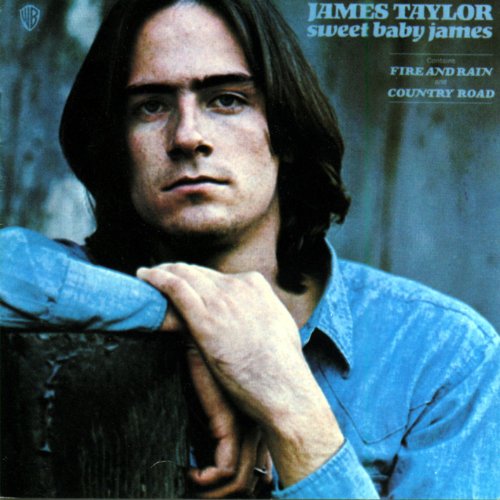
James Taylor’s Sweet Baby James
James Taylor’s second album, Sweet Baby James, is perhaps most notable for producing the single Fire and Rain. Along with his cover of Carole King’s classic You’ve Got a Friend the following year, it kick-started Taylor’s career, bringing him critical and commercial success. These were Taylor’s first chart high chart entries; indeed, You’ve Got a Friend was his first no.1. Sweet Baby James reached no.3 on the Billboard chart, but only after Fire and Rain’s release – the single also topped at no.3.
The atmosphere of the album is beautifully summed up by William Ruhlmann, writing for AllMusic: “Taylor didn’t break your heart; he understood that it was already broken, as was his own, and he offered comfort.” This mood pervaded much of the music of the early 70s, and given the social context, this is not surprising; this was being produced in an America that was still reeling from Vietnam, the assassinations of Martin Luther King and Robert F. Kennedy, and the murders committed by cult leader Charles Manson.
But there’s a personal touch to Taylor’s sorrows, too. At the time of the album’s release, he was only 22, but already had a history of drug use and mental health problems. He had only just checked out of Austen Riggs, a mental health institution in Massachusetts, when the album was recorded, having become addicted to heroin and methedrine while working on previous projects. The lyrics for Fire and Rain were inspired by the suicide of Suzanne Schner, a close friend of Taylor’s from the hospital.
Despite leaving, he was still facing personal difficulties when the album was recorded; he had no permanent home of his own, and so he was, in modern vernacular, couch-surfing, staying with his manager, Peter Asher (formerly affiliated with the Beatles’ record label, Apple), his friend and guitarist, Danny Kortchmar (who played on the album), and anyone else who would take him in. So desperate was he for the 20,000 he was promised when the album was finished, he stitched together three unfinished songs into a “suite” to form the last track that was needed for the record’s completion, and named it Suite for 20G.
Asher nurtured this pain and helped create a stripped-down, simple, and honest masterpiece. The album only cost 7,600 to produce, despite the initial budget of 20,000. And Asher and Taylor had learned from their mistakes on the first album, which, although met with moderate critical acclaim, was not well marketed due to Taylor’s hospitalisation and inability to promote it.
The general consensus, however, was that the first effort had been too ornate, too complicated, obscuring what Taylor wanted to say rather than enhancing it. Kortchmar credited Asher with the new sound; speaking about Fire and Rain, he said that “the bigger version diminished the power of the song.” And although the album only sold modestly on release, the Fire and Rain single and a Time cover story the following year triggered much larger commercial success.
Taylor’s sound on this album is a blend of different styles – mostly folk-rock, but with a good helping of blues thrown in for good measure. This is particularly evident on tracks like Steamroller, with trademark chord progressions and big band style brass arrangements. There are also hints of country music; Taylor is cited as an influence by country star Garth Brooks, and it’s easy to see why with frequent steel-stringed guitars and religious imagery pervading the album.
On the subject of imagery, it is sublime throughout. Steamroller features the following lines:
I’m a napalm bomb for you baby,
Stone guaranteed to blow your mind
And if I can’t have your love for my own, sweet child,
There won’t be nothing left behind.
In Gary von Tersch’s contemporary review, he described this as “a double-entendre tour-de-force pulled off effortlessly.” And the lyrics of Fire and Rain, with its “sweet dreams and fire machines in pieces on the ground,” are equally beautiful.
On this album, Taylor reacts to the overly ornate sound of his debut by showing that less is indeed more. He transforms pain to beauty in a way reminiscent of a musical Van Gogh, defining the folk-rock sound of healing that epitomised the singer-songwriter era of the early 70s.
Remember to check out tracks from this album, along with the others I’ve listened to, on the Spotify playlist.
